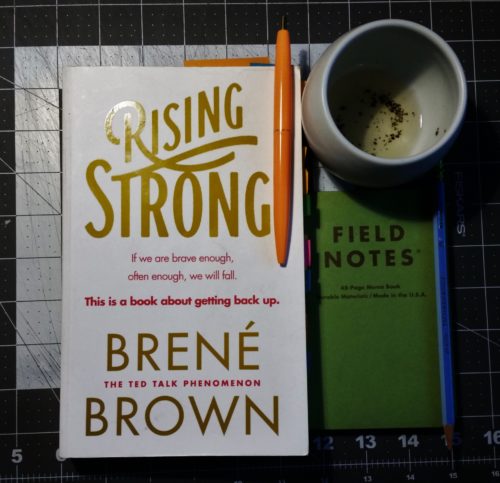Brown is best known for her TED talk on vulnerability, which is very very good. I’ve now read all 3 of her books, and if I’m going to compare the 3, Rising Strong is my least favorite. That said, I picked it because it links in really well with what I’ve been working on with folks in therapy groups lately- that as people have begun to recover from their mental health problem- depression, substance abuse, anxiety or some other problem and the question of how to cope with the change between illness and wellness is occasionally overwhelming.
What Brown does in RS is explore how as a culture we sanitize our stories of healing- “I fell down, but I got up again, and I’m okay.” When the real story is, “I fell down, skinned my knee, got bloody and bruised, rolled around in the mud for a bit crying, then got up, cleaned up the blood and mud, applied some ointment and band-aids, healed, and not I’m doing okay.” The former is easy to hear, but people get uncomfortable when friends and family talk about the blood, bruises, and ointments used in healing. We don’t tell the necessary stories because they hurt to tell, it’s easier to gloss over that info and move on with out lives. (This is where therapy comes into play, and hopefully if you need to talk about the blood and ointment of the healing process you have a therapist or group where you can share your stories. Of course, there is always your JOURNAL…)
Pages 5- 11 details Brown’s “rising strong” process. Much of this deals with how to heal, how to look at the process, the use of creativity, and honoring the struggle. Page 10 begins my struggle with this book. In her past books, I never notice a mention of any spiritual practice or religion anywhere, however on page 10 Brown states, “Rising strong is a spiritual practice.” In my mind, spiritual is a loaded term, one that implies religion or religiosity. As a therapist I have ethical qualms around bringing spirituality into practice, unless the client does so first. The topic is explored in a non denominational manner and more of a earthy crunchy hippie manner, which makes it much more tolerable. The aspect of spirituality runs through the book- as it is part of the 10 point process of rising strong this is to be expected. Religion is much more closely connected to the process later in the book, and I think detracts from the effectiveness as well as ability to generalize the book in it’s usefulness to more people.*
On page 19, Brown explores the amazingly useful phrase, “The story I’m making up….” She does this with a personal anecdote, but the story perfectly explains how people miss connections with one another and make up stories in their head to explain the missed connection. This is, I think possibly the most important page in the whole book. It has vast possible uses with clients and in our own lives. If we stop to think to ourselves, “The story I’m making up is…” How would that change how we interact with people? I suspect it has vast consequences for relationships.
I highly recommend Brown’s first 2 books, this one is okay, but not my favorite. It’s worth a read and has many useful passages that can be used in therapy or for self care.
Next week I’ll comment on Danny Gregory’s “Shut Your Monkey.”
*Brown goes into detail of her personal faith in several parts of the book.
Brown, B. (2015). Rising strong. London, London: Vermillion.
Yes, all links in this post are Amazon Affiliate links. I get a few pieces of coin should you chose to purchase the book through these links. No it is not a lot of coins. Every penny helps to buy more books, art supplies, and yes to keep this blog up and running.